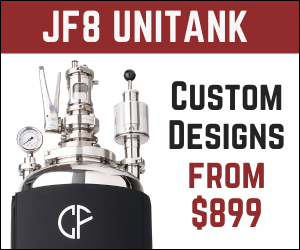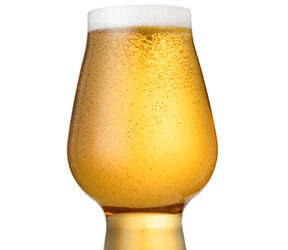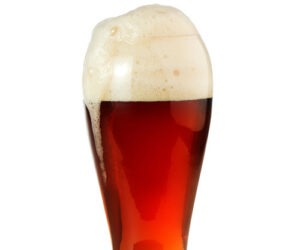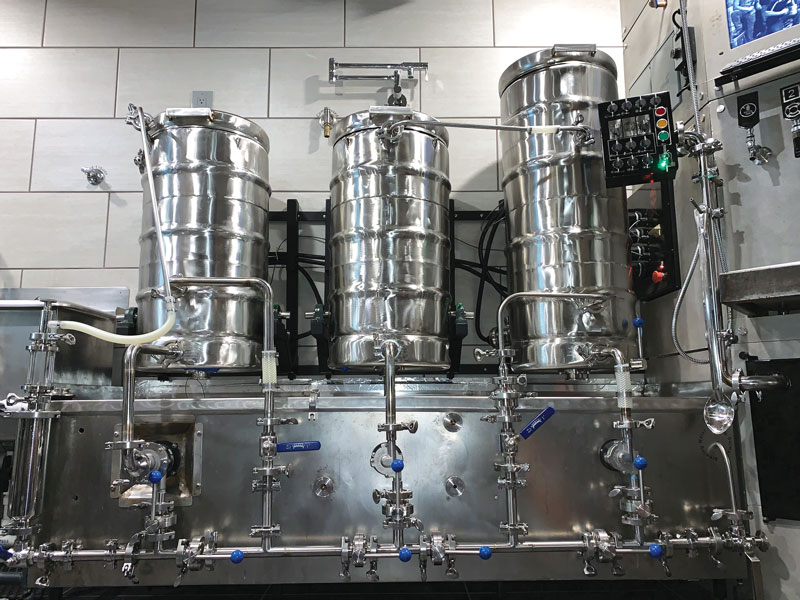Märzen: The Traditional Oktoberfest Lager
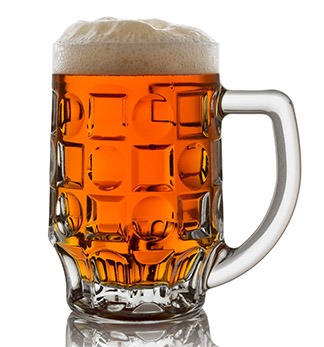
When I first started learning about world beer styles more than 30 years ago, Oktoberfest seemed fairly straightforward. It was an amber-colored, malty, German lager that routinely appeared in late summer as a festive seasonal for the cool weather. There were many German brands, and they were all labeled Oktoberfest, Oktoberfestbier, or Oktoberfest-Märzen. American microbreweries frequently had a similar seasonal offering, although few would match the malt character of the best German examples, and some were a bit too hoppy. This matched many other styles of the time; there were traditional examples, as well as American interpretations.
Ah, if life could only be so simple. The real story is quite a bit more complicated, and it requires learning some new terms for beers we thought we knew. Oktoberfestbier has a specific meaning in Germany and is treated like a protected appellation, not a style. It is used by the six large breweries within the city limits of München (Munich) to describe the beer served at the annual Oktoberfest festival, which has been held in the meadow fairgrounds just outside the city gates since 1810.
The name Oktoberfest-Märzen is perhaps the most accurate name, since it combines both the appellation and the style. The Märzen-style amber lager of Munich is related to the Vienna amber lager of Austria, in that they have a common history and were introduced in the early 1840s. But the first beers at Oktoberfest were actually dark lagers (Munich dunkel style). The Märzen style was served at the festival from 1872 until 1990, when the golden festbier style was adopted.
Imports to America often were the traditional amber Märzen, even after festbier was introduced, and were frequently labeled as Oktoberfest. European Union rules don’t apply to exports or to producers outside Germany, so the confusion persisted. When trying to sort these things out for beer judging purposes, the Beer Judge Certification Program (BJCP) decided to take the unpopular but accurate choice of avoiding the Oktoberfest name entirely. The BJCP Style Guidelines includes Märzen as Style 6A, part of Category 6, Amber Malty European Lager, which also includes rauchbier and dunkles bock. The related festbier is Style 4B, and represents the modern beer served at Oktoberfest.
History
The origin of the Oktoberfest version of Märzen is actually pretty well known. Prior to the version we know, Märzen was originally a name used for a strength band of beer (14 °Plato) and was applied to the dark brown beers of the time. The name Märzen is derived from März (March), implying brewing the beer at the end of the brewing season, lagering it in cool caves over the summer, and enjoying it in the fall. This was before the advent of mechanical refrigeration, which was not available before the 1870s.
Original usages aside, since 1841 Märzen has been used to describe the amber lager introduced by Gabriel Sedlmayr at the Spaten Brewery in Munich. Sedlmayr and his friend Anton Dreher, from Vienna, visited Great Britain in 1833 to learn more about English and Scottish brewing. Armed with a saccharometer (a type of hydrometer), they measured samples they were able to obtain (albeit somewhat surreptitiously), and learned more about attenuation and process control. They also studied malting and kilning to learn about improving their ingredients. They already had proper lager yeast and wonderful hops at their disposal.
Sedlmayr and Dreher each introduced similar styles in 1841, which is why the styles are sometimes known as Vienna/Märzen/Oktoberfest. Vienna and Märzen styles took their own paths after this introduction, with the Märzen becoming a bit stronger as it was adopted as a festival beer (which are traditionally about 2% stronger than “regular” beers) in 1872. It was to remain the standard festival offering for over a century before preferences for lighter-colored, more drinkable styles resulted in festbier being adopted at Oktoberfest in 1990.
Export German versions of Oktoberfestbier to the U.S. and elsewhere are typically based in the Märzen style, although labeling and formulation can vary by brewery (some German examples are definitely the modern version — check the appearance before purchasing). Craft versions of Oktoberfest are usually based on Märzen, including what is known by the Brewers Association Guidelines as American-Style Maerzen/Oktoberfest. This style is exemplified by the hoppier, more bitter Samuel Adams Octoberfest beer, which has a different balance than the German versions.
Sensory Profile
Märzen is an amber German lager, so it has a character like other German lagers — smooth, clean, properly fermented, and lagered. The color is amber-orange to deep reddish-copper; basically, darker than gold but lighter than brown. It has brilliant clarity and should have a persistent, off-white head.
The balance is malty, so bitterness should just support the malt but not enough that the finish is bitter. German lagers are generally dry to off-dry, so the beer should be attenuated, not sweet or heavy. The impression of maltiness comes from high-kilned base malts and lower hop rate, not from residual sweetness. The malt aroma and flavor is bready, rich, and somewhat toasty. Noticeable caramel, chocolate, biscuit, or roast flavors are out of place. Hop aroma and flavor are low to none with a soft floral, herbal, or spicy quality if detected.
The beer is medium-bodied but with a smooth texture from lagering, and has moderate carbonation. It shouldn’t taste of alcohol, but may be very lightly warming (it is an approximately 6% alcohol beer, after all). It should have a malty finish and aftertaste, but be attenuated enough that another drink is welcome. The best examples have an elegant, rich flavor profile suggestive of quality ingredients. Harsh, sharp, or rough flavors are not appropriate.
Brewing Ingredients and Methods
Grist formulations can vary quite a bit, but usually have some mixture of Pilsner, Vienna, and Munich base malts. Additional flavor and color malts can be used to darken the beer and enrich the flavor, with darker Munich malt, toasted malts, and a light use of crystal-type malts possible. The trick is getting the richness of flavor and amber color without any roasted notes. Munich-type malts are often the dominant flavor, but the beer shouldn’t wind up being as heavy as a bockbier.
Early books on the style, such as George Fix’s Vienna/Märzen/Oktoberfest, stressed quality ingredients as necessary for a rich, elegant malt profile. I believe his point was mostly about using continental 2-row malts, not domestic 6-row malts when brewing this style. This is less of a problem today, but I do believe European maltsters’ offerings are a better flavor fit for this traditional style.
Decoction mashes were traditional for styles of this era, although German brewers have mostly switched over to step mashes today. Step mashes can make very good German beer, but sometimes the grist needs to be adjusted with a higher percentage of Munich malt and possibly some increased color and flavor malts. The mash program should target a moderate-bodied beer, not something super crisp and dry. Homebrewers can use a single-infusion mash in the moderate temperature range (151–153 °F/66–67 °C) for this beer.
Water isn’t a major factor in this style, as there is not a minerally flavor profile evident. I would tend to use lower ion water sources, and to emphasize calcium chloride as the calcium source to help play up the maltiness in the beer. Munich water tends to have higher carbonate levels, but this should be removed before brewing (or another option is to use reverse osmosis water, as I do).
Traditional German hop and yeast choices will work here. Hallertauer is the classic German hop used by Munich breweries, so that would be my first choice, but the hops are subdued so this isn’t a major driver of the profile. Any of the other Saazer or noble-type hops could be used; Tettnanger would be my second choice.
A clean German yeast strain is required, and the Weihenstephan 34/70 strain is a great performer. This yeast can be found from a number of liquid suppliers (Wyeast 2124, White Labs WLP830, Imperial L13, Omega OYL-106), and is even available in dried form (SafLager W-34/70). While derived from the same strain, there can be some performance differences; I’ve had good luck with Wyeast 2124, so that’s what I tend to use. I also like using the WLP833 (German Bock) yeast since it makes the beer seem maltier. WLP833 is the Ayinger yeast, so if you like that flavor, that’s one to try. I would avoid any yeast strains that are higher sulfur producers.
I find warming the temperature for a diacetyl rest at the tail end of fermentation is completely unnecessary if you avoid strains that are known diacetyl producers and follow good fermentation practices (adequate pitch rate, oxygenation, and nutrients). Taste your beer before racking and decide if it needs it.
Lagering helps reduce yeast byproducts and produce a well-conditioned, smooth finished beer. The old German rule of one week of lagering for each degree Plato of original gravity can be followed, although many commercial breweries in Germany now simply kräusen their beer to accelerate the conditioning. To kräusen, add 1–2 quarts (1–2 L) of actively fermenting yeast to the beer when it still has 4–6 gravity points remaining to attenuate, then cool slowly to lagering temperature and lager for two weeks. Lagering at freezing temperature (32 °F/0 °C) produces better, faster results.
Homebrew Example
My version is a competition-type beer I make, which shoots for the malty side of the style with maximum flavor. I’m basically trying to get as close to a bock without it seeming bock-like. Judges seem to favor richer malt flavors in this style, and that’s also in line with my personal preferences, so that’s what’s guiding my choices here.
My Märzens always seem to start with equal parts Pilsner, Munich, and Vienna malts, before I start customizing. In this case, I’m bumping up the Vienna malt more, and adding some dark Munich as well for extra maltiness. Not satisfied with that, I throw in some aromatic malt for extra malt flavor, melanoidin malt for some rich toast, and a touch of CaraMunich® III for color and a hint of caramel richness. I often use German maltsters (Belgian for the aromatic) for authenticity and because I prefer these flavors for the Märzen style.
With all the boosted specialty malts, I can safely use an infusion mash at 152 °F (66 °C), followed by a mash-out. All of the German noble hops are fine and can be freely substituted since they are not playing a major role in the final profile. For maximum maltiness, I’ll go with the Ayinger yeast strain. It gives a little extra special flavor I enjoy, but the more neutral 34/70 strains can be used and make a delicious beer as well. The water profile is neutral and favors the malt. Fermentation and lagering are traditional, with me preferring to go old school and use a long lagering process.
As I said, this is a competition beer. It is a bit bigger, sweeter, and maltier than many modern German examples. I do think the traditional fermentation and lagering process has benefits in the smoothness of the beer and cleanness of the flavor profile. You can approximate those with faster approaches, but again, in competitions, every little edge gives you a boost. Even if you are making this for yourself and your friends, I hope you will appreciate the boldness of the result as much as most judges do.
Marzen: By the Numbers
OG: 1.054–1.060
FG: 1.010–1.014
SRM: 8–17
IBU: 18–24
ABV: 5.6–6.3%
Märzen
(5 gallons/19 L, all-grain)
OG = 1.060 FG = 1.014
IBU = 22 SRM = 11 ABV = 6.1%
This is a competition beer. It is a bit bigger, sweeter, and maltier than many modern German Märzen examples, which judges often prefer.
Ingredients
4.5 lbs. (2 kg) German Vienna malt
3 lbs. (1.4 kg) German Pilsner malt
3 lbs. (1.4 kg) German Munich malt
1 lb. (0.45 kg) German dark Munich malt
8 oz. (227 g) melanoidin malt
8 oz. (227 g) aromatic malt
4 oz. (113 g) Weyermann Cara-Munich® III malt
4 AAU German Tradition hops (60 min.) (0.67 oz./19 g at 6% alpha acids)
1 oz. (28 g) German Hallertauer hops (20 min.) (4.8% alpha acids)
White Labs WLP833 (German Bock), Omega Yeast OYL-111 (German Bock), or SafLager W-34/70 yeast
3⁄4 cup corn sugar (if priming)
Step by Step
This recipe uses reverse osmosis (RO) water. Adjust all brewing water to a pH of 5.5 using phosphoric acid. Add 1 tsp. of calcium chloride to the mash.
Mash in Vienna, Pilsner, Munich, dark Munich, and aromatic malts at 152 °F (67 °C) and rest for 60 minutes. Add remaining malts, begin recirculating, and raise mash temperature to 168 °F (76 °C) by direct heat or infusion with boiling water and rest for 15 minutes. Rest at mashout temperature for 20 minutes while recirculating. Sparge slowly with 170 °F (77 °C) water, collecting 6.5 gallons (25 L) of wort.
Boil the wort for 90 minutes, adding hops at the times indicated in the recipe.
Chill the wort to 50 °F (10 °C), pitch the yeast, then ferment until complete. Rack and lager for 8–12 weeks at 32 °F (0 °C). Prime and bottle condition, or keg and force carbonate.
Märzen
(5 gallons/19 L, extract with grains)
OG = 1.060 FG = 1.014
IBU = 22 SRM = 11 ABV = 6.1%
Ingredients
5.9 lbs. (2.7 kg) Munich liquid malt extract
2 lbs. (0.9 kg) Pilsner liquid malt extract
0.5 lbs. (227 g) melanoidin malt
4 oz. (113 g) Weyermann Cara-Munich® III malt
4 AAU German Tradition hops (60 min.) (0.67 oz./19 g at 6% alpha acids)
1 oz. (28 g) German Hallertauer hops (20 min.) (4.8% alpha acids)
White Labs WLP833 (German Bock), Omega Yeast OYL-111 (German Bock), or SafLager W-34/70 yeast
3⁄4 cup corn sugar (if priming)
Step by Step
Use 6 gallons (23 L) of water in the brew kettle; heat to 158 °F (70 °C). Steep the CaraMunich® and melanoidin malts for 30 minutes, then remove, allowing them to drip dry into the kettle.
Turn off the heat. Add the malt extracts and stir thoroughly to dissolve completely. You do not want to feel liquid extract at the bottom of the kettle when stirring with your spoon. Turn the heat back on and bring to a boil.
Boil the wort for 60 minutes, adding remaining hops at the times indicated.
Chill the wort to 50 °F (10 °C), pitch the yeast, then ferment until complete. Rack and lager for 8–12 weeks at 32 °F (0 °C). Prime and bottle condition, or keg and force carbonate.
